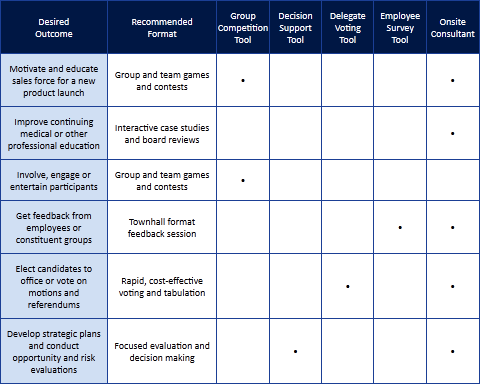Audience response integration guidelines
You may choose to integrate an audience response system solution into your next meeting or event for several reasons. Our flagship OptionPower software is unique in that we offer specialized tools for a wide variety of desired outcomes. We don’t try to fit your needs into a one-size-fits-all software application, and neither should you.

“Things went GREAT in Anaheim last week. Big thanks to you and Josh for making it happen. Anytime ...
Andrew W., Executive Producer

meeting formats
- Group and team games and contests (motivate and educate sales force or any other audience)
Typically a corporate celebrity or host presides over the program, much like a television quiz show. Question and answer options appear on-screen. Members of the audience indicate their answer by using a wireless audience response system keypad. Individual, regional or district scores are instantly tabulated and available for display. - Interactive case studies and board reviews (improve medical and other professional education)
Speakers present different case studies and ask for each participant to choose the correct diagnosis or solution. Summary results are displayed immediately for discussion. At the conclusion of the meeting, participants are given an individual report of their performance. Scoring is automatically maintained for CME, CLE and other CPE audit requirements. - Town Hall session (collect feedback from employees or constituent groups)
Invaluable for employee climate surveys, town hall meetings and customer feedback sessions, this form of interactive group response feedback encourages honest responses and open discussion about key issues. More importantly, this interactive format will let you go beyond simply finding out what everyone thinks. You’ll discover why they think that way and then be able to focus on appropriate action steps. - Electronic voting session (electing candidates to office or voting on motions and referendums)
The fastest and most inexpensive way available to conduct an election. Your voting delegates can instantly select from long lists of candidates. Results can be tabulated so quickly that the time you usually spend on elections can be cut by as much as 90%. - Focused evaluation and decision making (determine the best choice from a list of alternatives) Participants evaluate and rank long lists of ideas or initiatives using the Decision Support tool. An onsite consultant will help you design ranking exercises and facilitate discussion, if desired.

